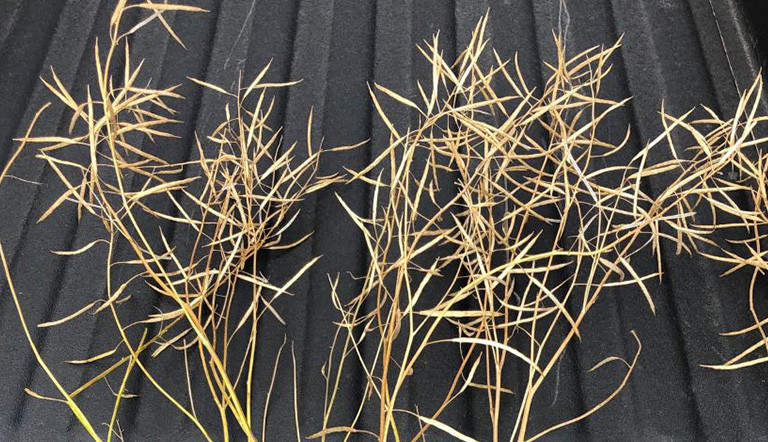
Pest Profile: Verticillium Stripe

Photo Credit: Canola Council of Canada
Disease symptoms in canola include leaf chlorosis, early ripening, stunting and, as the disease progresses, shredding of the stem tissue. Tiny black dots, called microsclerotia, infect the tissue on the stem and can fall into the soil, surviving there for many years and potentially infecting other fields.
IDENTIFICATION
Symptoms of this disease can be noted on the leaves and pods, but are more noticeable on the stem on roots, varying according to environmental factors and plant stage. The disruption of water and nutrient uptake causes stunting, brittle stems and faint black vertical striping on the stems, which becomes more noticeable when peeling back the skin. Later in the season, microsclerotia will begin to develop, which are also more noticeable beneath the epidermis. The striping will become more obvious in more mature plants due to the dying tissues beneath the stem surface, and near the end ripening, the microsclerotia will begin to germinate and produce conidia spores, giving the stems a powdery appearance.
Verticillium Stripe is often mistaken for other diseases, such as sclerotinia stem rot and blackleg, but upon careful investigation, the differences are more obvious. Sclerotinia’s large sclerotia and hollowing inside the stem is different from the tiny microsclerotia of verticillium stripe, and while the discoloured stem and premature ripening could point to blackleg, the stem affected by verticillium stripe does not have blackening in the stem cross-section at ground level as it does with blackleg.
CONTROL TIPS
- At this time there are no treatment fungicides currently registered for control of verticillium stripe in Canada. Control measures for the closely V. dahlia (which can cause verticillium stripe, include:
- Scout just before or just after harvest when symptoms are most obvious
- Increasing rotation length of non-host crops
- Weed management
- Increasing soil futility
- Use of non-host trap crops
- Fumigation (vapam and chloropicrin)
References and Additional Reading
“Verticillium Stripe” Canola Council of Canada. Online.
https://www.canolacouncil.org/canola-encyclopedia/diseases/verticillium-stripe/
“Verticillium Disease Etiology and Nursery” Canola Council of Canada. Online.
https://www.canolacouncil.org/research-hub/verticillium-disease-etiology-and-nursery/
“Verticillium Stripe” Manitoba Canola Growers. Online.
https://canolagrowers.com/resource/verticillium-wilt/